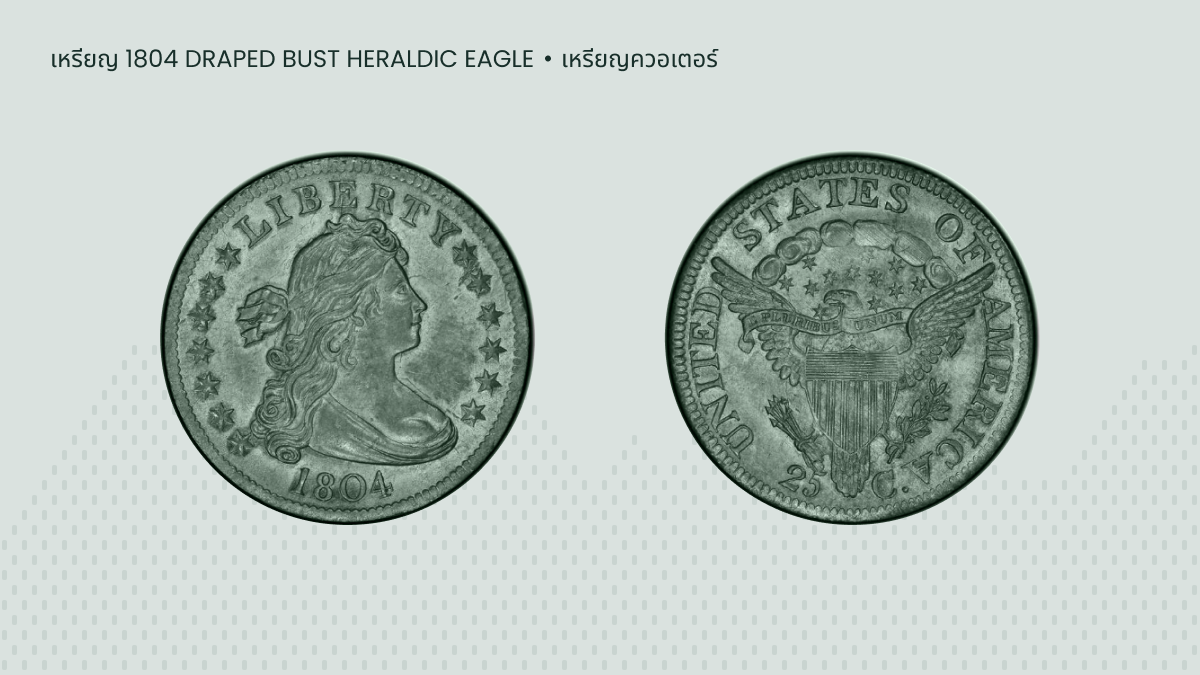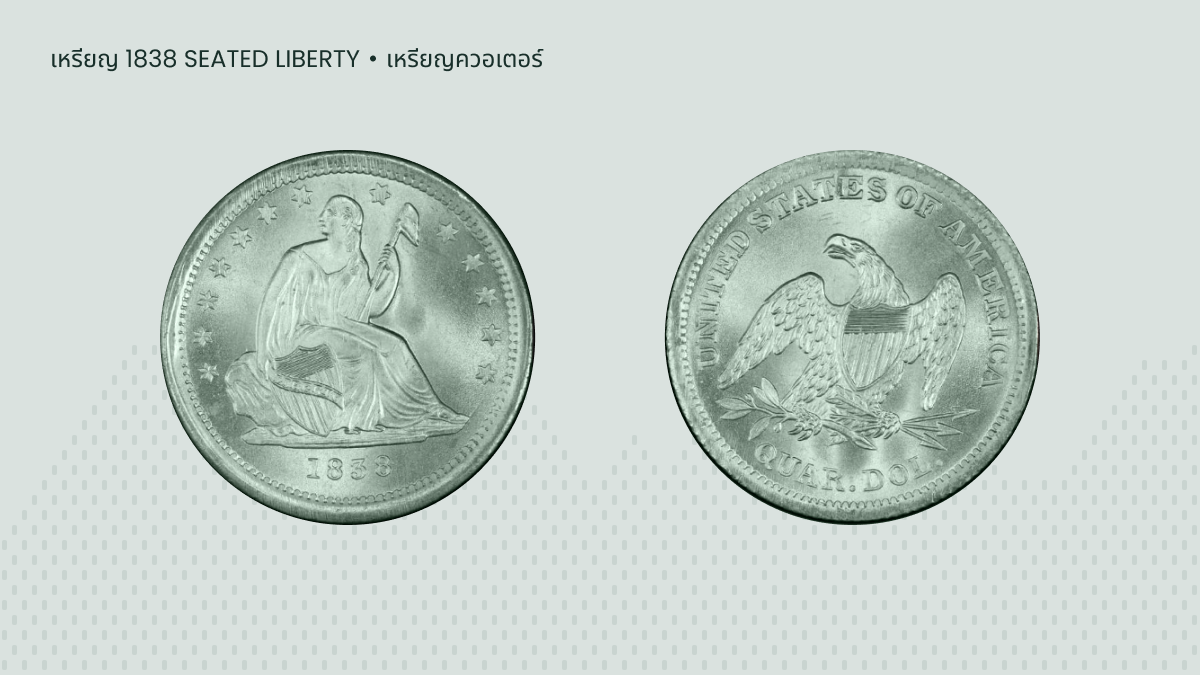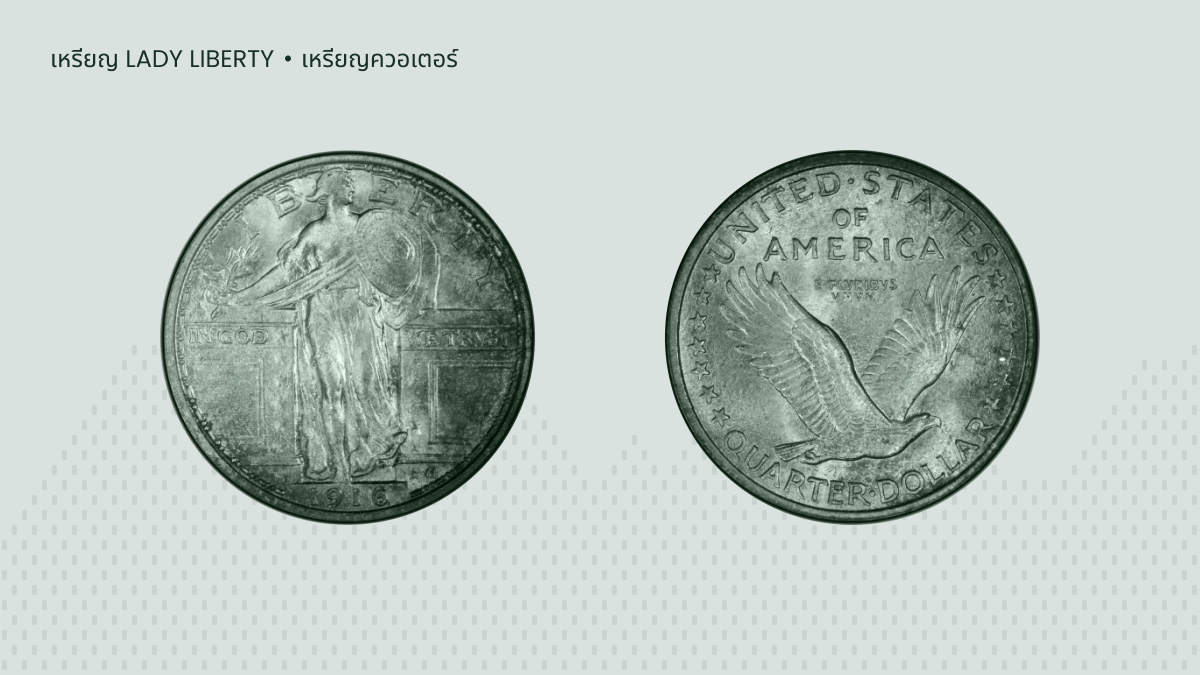ความหายาก เหรียญควอเตอร์ที่หายากมักจะมีมูลค่าสูงกว่าในตลาดสะสมเหรียญ สิ่งที่ทำให้เหรียญหายากอาจรวมถึงรุ่นเฉพาะ จำนวนการผลิตที่น้อย และข้อผิดพลาดที่เกิดจากการผลิตในอดีต เหรียญที่ผลิตที่โรงกษาปณ์บางประเภท โดยเฉพาะอย่างยิ่งหากผลิตในจำนวนน้อย อาจเป็นที่ต้องการมากกว่า ซึ่งทำให้มีมูลค่าสูงขึ้น คอยจับตาดูรอยต่าง ๆ บนเหรียญให้ดี ๆ ไม่ว่าจะเป็นรอยประทับแม่พิมพ์สองครั้งในหนึ่งด้าน (doubled dies), รอยประทับแม่พิมพ์สองรูปแบบในหนึ่งด้าน (die clashes) หรือรอยที่แม่พิมพ์ประทับไม่ตรงตำแหน่ง (misaligned strikes) ปัจจัยเหล่านี้ทำให้เหรียญควอเตอร์มีมูลค่ามากขึ้นเนื่องจากเหรียญมีเอกลักษณ์เฉพาะตัว
สภาพ ตามกฎทั่วไป ยิ่งเหรียญมีการสึกหรอและเสียหายน้อยเท่าใด เหรียญก็ยิ่งมีคุณค่ามากขึ้นเท่านั้น สภาพของเหรียญเรียกว่า เกรด และถูกกำหนดโดยปัจจัย 6 ประการ: การประทับตรา การเก็บรักษา ความแวววาว สี ความน่าสนใจ และสถานที่ผลิตเหรียญ
ความต้องการ เหรียญที่นักสะสมนิยมมีมูลค่ามากกว่า แนวโน้มของตลาดมักจะขึ้นอยู่กับของหายาก ความสำคัญทางประวัติศาสตร์ องค์ประกอบการออกแบบที่เป็นเอกลักษณ์ และธีมเฉพาะ
โดยเหรียญสามารถถูกให้คะแนนได้อย่างน่าเชื่อถือที่สุดโดยบริษัทเกี่ยวกับเหรียญมืออาชีพซึ่งเป็นบุคคลที่สาม ซึ่งทำงานตามมาตรฐานอย่างเป็นทางการในปี ค.ศ. 1977 ที่เผยแพร่โดย American Numismatic Association (ANA) ตารางด้านล่างแสดงการให้คะแนนเหรียญพื้นฐานและความหมาย:
เกรด | คำอธิบาย |
PROOF – (PF/PR) | เหรียญที่ไม่ได้ผลิตเพื่อใช้หมุนเวียนในระบบ รายละเอียดคมชัด และมักจะมีพื้นผิวเงาเหมือนกระจก การขัดเงานั้นไม่ใช่สภาพ แต่เป็นวิธีการผลิต โดยใช้แผ่นโลหะพิเศษและแม่พิมพ์ขัดเงาเพื่อพิมพ์เหรียญขัดเงา ผลิตเพื่อนักสะสมเป็นหลัก เหรียญขัดเงาจะไม่นำมาใช้หมุนเวียนในระบบ |
MINT STATE(MS, UNC) | เหรียญไม่มีร่องรอยใด ๆ ดังที่อธิบายไว้ด้านล่าง ร่องรอยตำหนิ สีผิวเหรียญที่เปลี่ยนไป และความไม่สมบูรณ์เล็กน้อยอาจทำให้เหรียญดังกล่าวแตกต่างไปเล็กน้อย |
PERFECT UNCIRCULATED (MS-70) | ไม่มีร่องรอยสึกหรอเลย ไม่มีรอยขีดข่วน รอยนิ้วมือ หรือรอยที่สัมผัสกับเหรียญอื่น เหรียญไม่ขัดเงารุ่นปกติ สภาพนี้แทบไม่เคยพบเลย |
GEM UNCIRCULATED (MS-65 to MS69) | เหรียญที่ไม่ได้นำไปใช้หมุนเวียนที่มีรูปลักษณ์สวยงาม สีผิวเหรียญที่เปลี่ยนเล็กน้อยและร่องรอยการสัมผัสบนพื้นผิวหรือขอบเล็กน้อยนั้นยอมรับได้ |
CHOICE UNCIRCULATED (MS-63 to MS64) | เหรียญไม่มีการหมุนเวียนโดยเฉลี่ยที่สูงกว่า มันอาจจะเงาแวววาวหรือสีเปลี่ยนเล็กน้อยมาก ๆ สามารถมีรอยสัมผัสเล็ก ๆ น้อย ๆ บนพื้นผิวหรือขอบเหรียญได้ |
UNCIRCULATED (MS-60 to MS62) | ไม่มีร่องรอยของการสึกหรอ มีร่องรอยการสัมผัส อาจไม่เหลือความเงาแวววาวแล้ว |
CHOICE ABOUT UNCIRCULATED (AU-55 TO AU58) | เฉพาะจุดที่นูนสูงที่สุดของการออกแบบบนเหรียญเท่านั้นที่อาจแสดงร่องรอยสึกหรอที่เล็กน้อยที่สุด ยังมีความเงาแวววาวอยู่ |
ABOUT UNCIRCULATED (AU-50 TO AU53) | มีการสึกหรอเล็กน้อยในจุดนูนสูงต่าง ๆ อย่างน้อยต้องมีความแวววาวเหลืออยู่ครึ่งหนึ่ง |
CHOICE EXTREMELY FINE (XF-45 or EF-45) | โดยรวมมีการสึกหรอเล็กน้อยที่จุดนูนสูงที่สุด รายละเอียดการออกแบบทั้งหมดยังคงชัดเจน ยังมีความเงาแวววาวอยู่เล็กน้อย |
EXTREMELY FINE (XF-40 or EF-40) | การออกแบบมีการสึกหรอเล็กน้อย แต่รายละเอียดทั้งหมดของเหรียญจะต้องมีความชัดเจนและมีการกำหนดไว้อย่างชัดเจน อาจมีร่องรอยของความเงาแวววาวปรากฏอยู่ |
CHOICE VERY FINE (VF-30 to VF-35) | พื้นผิวและส่วนที่นูนสูงที่สุดบนการออกแบบเหรียญอาจมีการสึกหรอเล็กน้อยแบบพอ ๆ กันสม่ำเสมอ รายละเอียดการออกแบบและข้อความทั้งหมดไม่คมชัด แต่ยังมองเห็นได้อยู่ |
VERY FINE (VF-20 top VF-25) | จุดที่นูนสูงของการออกแบบเหรียญมีการสึกหรอปานกลาง มองเห็นรายละเอียดสำคัญทั้งหมดได้ แต่ความคมชัดลดลง |
FINE (F-12 to F-15) | มีการสึกหรอปานกลางถึงมาก การออกแบบสึกหรอค่อนข้างมากแต่ยังคงมองเห็นได้โดยรวม |
VERY GOOD (VG-8 to VG-10) | มีการสึกหรอมากแต่ยังมีรายละเอียดบนเหรียญยังชัดเจน |
เหรียญควอเตอร์ดอลลาร์ที่มีมูลค่าสูงที่สุด
ควอเตอร์ได้รับการผลิตมาเป็นเวลา 228 ปีแล้ว นี่คือรายละเอียดของเหรียญที่มีค่าที่สุด ตามลำดับเวลาตามปริมาณการผลิต เหรียญควอเตอร์ของคุณมีมูลค่าเท่าไร?
เหรียญควอเตอร์ Draped Bust Small Eagle ปี 1796

เทพีเสรีภาพหันหน้าไปทางขวาผูกริบบิ้นที่ปอยผมสลวย และหน้าอกของเธอคลุมด้วยผ้า มีคำว่า LIBERTY เขียนอยู่เหนือศีรษะของเธอ โดยระบุปีไว้ใต้หน้าอก และด้านหน้าเหรียญมีดาว 15 ดวง (หนึ่งดวงแสดงถึงหนึ่งรัฐ ณ ขณะนั้น) เหรียญเหล่านี้เป็นควอเตอร์ชุดแรกที่ผลิตขึ้นมา
ปัจจุบันดาวบนธงชาติสหรัฐอเมริกามีห้าสิบดวง ซึ่งหมายถึงห้าสิบรัฐ แถบบนธงทั้ง 13 แถบ หมายถึง อาณานิคมกลุ่มแรกที่ประกาศเอกราชจากบริเตนใหญ่เมื่อยี่สิบปีก่อนที่เหรียญควอเตอร์จะถูกผลิตขึ้น

ด้านหลังของเหรียญควอเตอร์แรกประดับด้วยนกอินทรีขนาดเล็ก และล้อมรอบด้วยมงกุฎลอเรล (สัญลักษณ์แห่งความสำเร็จและชัยชนะ) และคำว่า UNITED STATES OF AMERICA ทั้งสองด้านไม่มีชื่อของเหรียญระบุ
ในบรรดาเหรียญอเมริกัน เหรียญนี้เป็นหนึ่งในเหรียญที่หายากที่สุด ปัจจุบันเหรียญควอเตอร์ Draped Bust Small Eagle ปี 1796 ของแท้ มีเพียงประมาณหกร้อยเหรียญเท่านั้น ซึ่งคิดเป็นต่ำกว่า 10% ของจำนวนที่ผลิตในครั้งแรกทั้งหมด
เหรียญจากการผลิตนี้สามารถมีมูลค่าเริ่มต้นที่ประมาณ $1,000 ขึ้นอยู่กับสภาพของมัน เหรียญที่อยู่ในสภาพ Fine (F) หรือ Very Fine (VF) อาจมีมูลค่าหลายพันดอลลาร์, Extremely Fine (EF) หรือ About Uncirculated (AU) อาจสูงถึงหลายหมื่นเหรียญ และเหรียญ Mint State (MS) อาจมีมูลค่าได้ 6 หลัก หรือแม้แต่ราคา 7 หลักด้วยซ้ำ ในปี ค.ศ. 2022 เหรียญควอเตอร์ Draped Bust Small Eagle ปี 1796 เกรด MS-66 ถูกขายในราคากว่า 1,740,000 ดอลลาร์
เหรียญควอเตอร์ Draped Bust Heraldic Eagle ปี 1804

เหรียญนี้เป็นเหรียญที่มีมูลค่าสูงและมีความสำคัญทางประวัติศาสตร์ ด้านหน้าจะมีลักษณะเหมือนกับเหรียญควอเตอร์ปี 1796 ด้านหลังจะเป็นนกอินทรีตัวใหญ่กางปีก ถือลูกธนูอยู่ในกรงเล็บขวา และมีกิ่งมะกอกอยู่กรงเล็บซ้าย ด้านหน้ามีริบบิ้นที่มีข้อความ E PLURIBUS UNUM และโล่ที่มีแถบ 13 แถบ แต่ละแถบแสดงถึงแต่ละอาณานิคมอังกฤษดั้งเดิมที่รวมตัวกันเพื่อประกาศเอกราช ท้องฟ้าประดับด้วยดวงดาวและกลุ่มเมฆอยู่เหนือหัวนกอินทรี และมีการพิมพ์ 25 C ไว้ข้างใต้เหรียญ
ลูกศรและกิ่งมะกอกที่นกอินทรีเกาะอยู่เป็นสัญลักษณ์ของความแข็งแกร่งและความสงบสุขตามลำดับ นกอินทรีนั้นเป็นสัญลักษณ์ของระเบียบของรัฐบาลและเอกลักษณ์ประจำชาติ
เหรียญควอเตอร์นี้มีมูลค่าเท่าไร? เหรียญควอเตอร์ Draped Bust ปี 1804 เกรด Average Condition (AC) มีมูลค่าประมาณ 1,600 ดอลลาร์ อย่างไรก็ตาม ในเกรด MS คุณสามารถขายเหรียญนี้ได้ในราคา 157,700 ดอลลาร์
เหรียญควอเตอร์ Seated Liberty ปี 1838

กลางทศวรรษที่ 1830 มีการปฏิวัติเทคโนโลยีการทำเหรียญกษาปณ์ ก่อนหน้านั้น เหรียญถูกสร้างขึ้นโดยใช้แรงคนหรือแรงม้า โดยแต่ละครั้งจะผลิตเหรียญได้เพียงสิบเหรียญต่อนาทีเท่านั้น อย่างไรก็ตาม ในปี ค.ศ. 1831 การสำรวจพิเศษของศิลปินและนักเก็บเอกสารสำคัญ Franklin Peale เพื่อสังเกตโรงกษาปณ์ของยุโรปได้ให้ข้อมูลมากมายที่ช่วยกระตุ้นให้มีการปรับปรุงระบบโรงกษาปณ์ในสหรัฐอเมริกา จากนั้นจึงนำเทคโนโลยีพลังงานไอน้ำสุดล้ำสมัยก่อนที่จะมีการผลิตไฟฟ้าเกิดขึ้นมาใช้ในการผลิตเหรียญกษาปณ์


ในบรรดาเหรียญรุ่นแรก ๆ ที่ผลิตด้วยเครื่องพิมพ์พลังไอน้ำรุ่นใหม่คือเหรียญควอเตอร์ Seated Liberty ซึ่งได้รับการออกแบบใหม่ทั้งสองด้าน
ด้านหน้ามีเทพีเสรีภาพนั่งอยู่บนก้อนหินโดยหันลำตัวไปทางขวา แต่ศีรษะหันไปทางซ้าย เธอถือไม้เท้า (แสถงถึงการเป็นผู้มีอำนาจ) ที่มีหมวกทหารปฏิวัติอยู่บนปลายไม้ในมือซ้าย ด้านขวามีดาวและลายทางที่นูนขึ้น เธอถูกล้อมรอบด้วยดาวสิบสามดวง และปีพิมพ์อยู่ที่ด้านล่าง
ด้านหลังมีนกอินทรีสยายปีกถือลูกธนู (สงคราม) ไว้กรงเล็บด้านซ้าย และกิ่งมะกอก (สันติภาพ) อยู่กรงเล็บขวา มีโล่ที่มีลายทางด้านหน้า และล้อมรอบด้วยข้อความจารึกตามปกติ
ในสภาพแย่หรือทั่ว ๆ ไป เหรียญเหล่านี้อาจมีราคาเพียง 100 ดอลลาร์หรือน้อยกว่า แต่ในสภาพใหม่อาจมีมูลค่าหลายพันดอลลาร์ เหรียญจากการผลิตครั้งนี้มียอดประมูลที่น่าประทับใจสูงถึง 285,000 ดอลลาร์
เหรียญควอเตอร์ 1901-S Barber

ได้รับการออกแบบโดย Charles Barber ในปี ค.ศ. 1891 ซีรีส์เหรียญควอเตอร์ของ Barber สะท้อนถึงสไตล์ใหม่ เหรียญที่มีรูปลักษณ์โรแมนติกแบบอังกฤษนั้นล้าสมัย และเหรียญที่มีความล้ำสมัยและบรูทัลลิสต์มากกว่านั้นเป็นที่ต้องการมากกว่า ในหนังสือพิมพ์ เหรียญนี้ได้รับการอธิบายว่าเป็น “เงินที่น่าเกลียดที่สุดในบรรดาประเทศที่มีอารยธรรมทั้งหมด” และอธิบายไม้เท้าและหมวกในมือซ้ายของเทพีเสรีภาพว่าเป็น “ด้ามไม้กวาดที่มีหมวกคลุมผมทำจากผ้าขนสัตว์” (The Galaxy, 1876)
ด้านหน้าของการออกแบบใหม่ของ Barber มีความโดดเด่นด้วยรูปแกะสลักขนาดใหญ่ของเทพีเสรีภาพหันหน้าไปทางขวา สวมหมวกของนักปฏิวัติ และมีมงกุฎลอเรลบนศีรษะของเธอ ซึ่งมีดาวสิบสามดวงล้อมอยู่ มีข้อความ IN GOD WE TRUST เขียนไว้ด้านบน และวันที่อยู่ด้านล่าง ส่วนด้านหลังเป็นนกอินทรีอีกรูปแบบหนึ่งที่มีลูกศร กิ่งมะกอก กรอบนูน จะงอยปากคาบริบบิ้นที่พิมพ์ข้อความว่า E PLURIBUS UNUM และมีดาวอยู่เหนือศีรษะ
1901-S Barber เป็นเหรียญควอเตอร์ที่หายากจากโรงกษาปณ์ซานฟรานซิสโก เหรียญนี้ผลิตมาเพียง 72,664 เหรียญเท่านั้น เนื่องจากเป็นเหรียญหายาก เหรียญควอเตอร์ 1901-S Barber จึงมีมูลค่าหลายพันดอลลาร์แม้จะอยู่ในสภาพที่แย่ก็ตาม สำหรับสภาพทั่วไป มันอาจมีมูลค่าสูงถึง 20,000-50,000 ดอลลาร์ได้เลย เหรียญ 1901-S Barber เกรด MS-68 ได้รับการให้คะแนนโดย NGC ที่ถูกพบในปี 1990 ถูกขายไปในราคา 550,000 ดอลลาร์ บางทีคุณอาจมีเหรียญควอเตอร์ Barber ที่มีมูลค่าถึงครึ่งล้านเลยก็ได้นะ?
เหรียญ Standing Liberty (เปลือยอก) ปี 1916

เหรียญควอเตอร์แรกที่ไม่มีดาวอยู่ด้านหน้า เหรียญนี้มีเทพีเสรีภาพยืนอยู่ระหว่างแท่นบูชาลักษณะคล้ายแท่นบูชาของกรีกสองแท่น ซึ่งมีข้อความเขียนว่า IN GOD WE TRUST ร่างของเธอคลุมด้วยเสื้อคลุมและเปลือยหน้าอกขวา ซึ่งเป็นสัญลักษณ์ของบทบาทของมารดาของระบบธนาคารในการเจริญรุ่งเรืองของประเทศ มือซ้ายของเทพีเสรีภาพถือโล่
ด้านหลังเป็นรูปนกอินทรีที่กำลังบินอยู่ ดาว ข้อความ UNITED STATES OF AMERICA แสดงอยู่ด้านบน และข้อความ E PLURIBUS UNUM อยู่ด้านล่างข้อความนั้น และล่างสุดพิมพ์ว่า QUARTER DOLLAR
เหรียญนี้เป็นเพียงเหรียญเดียวที่แสดงหน้าอกเปลือยของเทพีเสรีภาพ และเนื่องจากเสียงโวยวายของสาธารณชน ในปีถัดมา ความน่าอายของเธอก็ถูกปกคลุมด้วยเกราะโซ่ถัก ในปี ค.ศ. 1916 เหรียญควอเตอร์ Standing Liberty ถูกผลิตขึ้นเพียง 52,000 เหรียญเท่านั้น เหรียญหายากนี้ในสภาพทั่วไป มีมูลค่า 2,800 ดอลลาร์ และเพิ่มขึ้นเป็นมากกว่า 18,000 ดอลลาร์ในสภาพที่ดียิ่งกว่า
เหรียญควอเตอร์ 1932-D Washington และ 1932-S Washington

ในปี ค.ศ. 1932 เมื่อจอร์จ วอชินตันมีอายุครบ 200 ปี สหรัฐอเมริกาได้เปลี่ยนหน้าเหรียญควอเตอร์จากรูปเทพีเสรีภาพเป็นรูปของประธานาธิบดีคนแรก
ตั้งแต่ปี ค.ศ. 1866 สหรัฐอเมริกามีกฎหมายห้ามมิให้วาดภาพบุคคลที่ยังมีชีวิตอยู่บนเงินของสหรัฐฯ
เหรียญควอเตอร์เหล่านี้เป็นเหรียญที่พบบ่อยและเป็นที่รู้จักมากที่สุด การออกแบบทั้งด้านหน้าและด้านหลังไม่มีการเปลี่ยนแปลงตั้งแต่ปี ค.ศ. 1932 ถึง 1998 ด้านหน้าเป็นรูปในตำนานของจอร์จ วอชิงตัน หันหน้าไปทางซ้ายใส่วิกผมปัดแป้งและรวบผมหางม้า ด้านหลังเป็นรูปนกอินทรีกางปีกแบบดั้งเดิม กำลังจับลูกธนูอยู่ที่เท้าทั้งสองข้าง และมีช่อลอเรลล้อมอยู่ข้างใต้ สัญลักษณ์โรงกษาปณ์ เช่น S หรือ D จะอยู่ใต้นกอินทรี อักษรเหล่านี้ระบุถึงซานฟรานซิสโกและเดนเวอร์ ตามลำดับ ในปี ค.ศ. 1932 โรงกษาปณ์ซานฟานซิสโกผลิตเหรียญได้ 408,000 เหรียญ และโรงกษาปณ์เดนเวอร์ผลิตได้ 436,800 เหรียญ
เหรียญที่อยู่ในสภาพไม่ดีจะมีมูลค่า 200 ดอลลาร์ ส่วนเหรียญที่ยังอยู่ในสภาพใหม่อาจมีราคาไปถึงหลักพันได้ ในปี ค.ศ. 2008 เหรียญรุ่น 1932-D ที่อยู่ในเกรด MS-66 ขายได้ในราคา 143,750 ดอลลาร์ และในปี ค.ศ. 2020 รุ่น 1932-S ขายได้ในราคา 45,500 ดอลลาร์
จะขายเหรียญควอเตอร์ของคุณได้ที่ไหน
คุณกำลังคิดที่จะสะสมเหรียญอยู่หรือเปล่า? คุณสามารถนำไปขายได้ในสถานที่ต่อไปนี้
ตัวแทนจำหน่ายเหรียญ
ตัวแทนจำหน่ายเหรียญจะซื้อจำนวนมากในราคาต่ำกว่ามูลค่าจริง 20-40% หากคุณต้องการเงินสดแบบด่วน ๆ นี่อาจเป็นที่ที่คุณกำลังมองหา อย่างไรก็ตาม สิ่งสำคัญมากคือต้องทราบมูลค่าเหรียญควอเตอร์ของคุณล่วงหน้าเพื่อให้แน่ใจว่าคุณจะไม่ถูกหลอก
ตลาดประมูล
ตลาดประมูลเหรียญเป็นแพลตฟอร์มที่คุณสามารถเข้าถึงผู้คนจำนวนมาก ทั้งนักสะสมและผู้ที่ชื่นชอบ พวกเขาเป็นตัวเลือกที่ยอดเยี่ยมสำหรับผู้ขายที่สามารถใช้เวลาในการขายเหรียญทีละรายการได้อย่างใจเย็น ผู้สนใจสามารถประมูลเหรียญควอเตอร์ของคุณได้ เหรียญที่มีมูลค่าอย่างแท้จริงจะทำให้ผู้ซื้อต่อสู้เพื่อแย่งชิงมัน ซึ่งสามารถดันราคาให้สูงขึ้นได้ ดังนั้น นี่จึงเป็นตัวเลือกที่ทำกำไรได้ค่อนข้างมาก การประมูลจะเรียกเก็บค่าธรรมเนียมคงที่หรือเป็นเปอร์เซ็นต์ของธุรกรรมแต่ละรายการ
นิทรรศการเหรียญสะสม
ในงานนิทรรศการแสดงเหรียญ คุณสามารถจัดแสดงเหรียญของคุณต่อผู้ชมเป้าหมายและสร้างเครือข่ายกับนักสะสมเหรียญคนอื่น ๆ ได้ หากคุณเข้าร่วมในฐานะผู้ขาย คุณสามารถจัดแสดงเหรียญของคุณเองและขายเหรียญของคุณให้กับนักสะสมได้โดยตรง การโต้ตอบแบบเห็นหน้ากันนี้ยังช่วยให้คุณประเมินได้ว่าเหรียญควอเตอร์ต่าง ๆ มีมูลค่าเท่าใด โดยพิจารณาจากความสนใจและคำติชมของผู้ซื้อในทันที
แพลตฟอร์มออนไลน์
แพลตฟอร์มออนไลน์ที่มีชื่อเสียงสำหรับการซื้อและขายเหรียญอาจเป็นสิ่งที่คุณกำลังมองหา สิ่งสำคัญอย่างยิ่งคือต้องทำความรอบคอบในการค้นหาแพลตฟอร์มดี ๆ อย่าเลือกแพลตฟอร์มใด ๆ เพียงเพราะว่ามันเป็นที่นิยม สิ่งสำคัญที่สุดคือ จงค้นหาแพลตฟอร์มที่จะดำเนินธุรกรรมของคุณได้อย่างปลอดภัย













